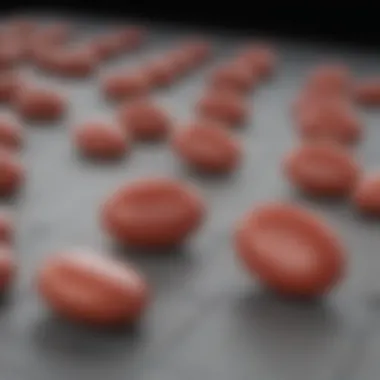Understanding Anti-Hypertensive Medications and Their Impact


Intro
Hypertension, commonly known as high blood pressure, is a persistent condition that can lead to severe health issues, including heart disease and stroke. The management of hypertension often necessitates the use of anti-hypertensive medications, which play a critical role in controlling blood pressure levels and improving overall cardiovascular health. Understanding the various classes of these medications and their mechanisms of action is essential for healthcare professionals, educators, and informed readers. This article delves into these aspects, offering a comprehensive guide to anti-hypertensive medications and discussing their significant implications on health.
Key Concepts
Definition of the Main Idea
Anti-hypertensive medications are pharmacological agents used to lower blood pressure in individuals diagnosed with hypertension. Their primary aim is to reduce the risk of complications associated with high blood pressure, such as heart attacks and strokes. These medications function through different mechanisms, which can affect the body in various ways, providing options for tailored treatment plans that suit individual patient needs.
Overview of Scientific Principles
The mechanisms of action for anti-hypertensive medications generally fall into several categories:
- Diuretics: These increase urine output, promoting the elimination of sodium and water.
- ACE Inhibitors: They prevent the formation of angiotensin II, resulting in blood vessel dilation.
- Beta-Blockers: These reduce heart rate and cardiac output.
- Calcium Channel Blockers: They prevent calcium from entering heart and blood vessel cells, leading to lower blood pressure.
- Angiotensin II Receptor Blockers: They block the effects of angiotensin II on blood vessels, causing vasodilation.
Each class has its unique profile of efficacy and side effects, necessitating careful consideration regarding patient selection and monitoring.
"The choice of anti-hypertensive medication should be based on individual patient characteristics, including comorbid conditions and potential side effects."
"The choice of anti-hypertensive medication should be based on individual patient characteristics, including comorbid conditions and potential side effects."
Current Research Trends
Recent Studies and Findings
Recent research in the field of anti-hypertensive medications has highlighted new trends and evidence in treatment protocols. Meta-analyses and randomized controlled trials continue to refine our understanding of these agents, especially concerning their long-term effects on patient health. Studies reveal that combining medications from different classes can yield better control of blood pressure and improve patient outcomes more effectively than single-drug therapy.
Significant Breakthroughs in the Field
Innovations in pharmacotherapy for hypertension have surfaced with ongoing research into novel medications that act through unique pathways. Furthermore, advancements in personalized medicine emphasize understanding genetic variations that influence individual responses to these medications.
As patient adherence remains a critical issue in hypertension management, research indicates the need for more user-friendly medication regimens, including fixed-dose combinations to simplify treatment.
Preamble to Hypertension
Hypertension is a critical health issue affecting millions worldwide. In this article, we will examine the essentials of hypertension, focusing on its definitions, classifications, and global impact on health. Understanding hypertension is vital for healthcare providers, as effective management is essential for reducing its complications, like heart disease and kidney failure.
Definition and Classification of Hypertension
Hypertension, or high blood pressure, refers to a condition where the force of blood against the artery walls is consistently too high. This condition can lead to serious health complications. It is classified into two main categories: primary (essential) hypertension and secondary hypertension. Primary hypertension has no identifiable cause and is often influenced by factors like genetics, diet, and lifestyle. On the other hand, secondary hypertension arises due to underlying medical conditions such as kidney disease or hormonal disorders.
Blood pressure is measured in millimeters of mercury (mmHg) and is represented by two numbers: systolic (pressure during heartbeats) and diastolic (pressure between heartbeats). A normal blood pressure reading is generally considered to be around 120/80 mmHg. Hypertension is typically defined as having a sustained reading of 130/80 mmHg or higher.
Recognizing the differences in classifications helps healthcare professionals tailor treatment strategies and formulate effective management plans.
Global Prevalence and Public Health Impact
Hypertension is a global epidemic, affecting roughly 1.13 billion people worldwide. This prevalence varies across different regions, largely influenced by social, economic, and environmental factors. The World Health Organization has recognized hypertension as a leading risk factor for cardiovascular diseases and premature mortality.
The public health impact of hypertension is profound. It contributes significantly to the burden on healthcare systems, demanding increased resources for management and treatment. Many individuals with high blood pressure are often unaware of their condition due to a lack of symptoms. This contributes to its nickname, "the silent killer."


Research indicates that effective management of hypertension can reduce the risk of stroke, heart attack, and kidney failure. Public health initiatives aimed at screening, education, and promoting healthier lifestyles are essential in mitigating the effects of this condition on a global scale.
Effective management of hypertension is crucial in reducing its societal and health burdens, making it an imperative focus for healthcare providers.
Effective management of hypertension is crucial in reducing its societal and health burdens, making it an imperative focus for healthcare providers.
Pharmacology of Anti-Hypertensive Medications
Pharmacology of anti-hypertensive medications is essential to understanding their role in hypertension management. These medications play a crucial part in controlling blood pressure and reducing risks associated with cardiovascular diseases. The pharmacological mechanisms provide insights into how these drugs work, their effectiveness, and potential side effects. With the increasing prevalence of hypertension, grasping these pharmacological concepts is vital for healthcare professionals as they make critical decisions in patient care.
Mechanisms of Action
Anti-hypertensive medications operate through diverse mechanisms to lower blood pressure. These mechanisms can vary significantly depending on the class of medication. Some common mechanisms include:
- Vasodilation: Certain medications, such as angiotensin II receptor blockers, relax blood vessels, allowing for easier blood flow. This leads to a decrease in overall blood pressure.
- Reduced Blood Volume: Diuretics reduce blood volume by promoting the excretion of sodium and water. This decreases the workload on the heart and lowers pressure within the blood vessels.
- Inhibition of Hormones: Drugs like ACE inhibitors prevent the formation of angiotensin II, a hormone that causes blood vessels to constrict. This action results in reduced vascular resistance and lowered blood pressure.
- Heart Rate Control: Beta-blockers work by decreasing heart rate and the force of contraction, which ultimately contributes to lowering blood pressure.
Understanding these mechanisms is crucial for recognizing which treatment might work best for individual patients based on their health profiles.
"A clear understanding of how anti-hypertensive medications function can greatly enhance treatment efficacy."
"A clear understanding of how anti-hypertensive medications function can greatly enhance treatment efficacy."
Pharmacokinetics and Pharmacodynamics
Pharmacokinetics and pharmacodynamics are two crucial components in the pharmacological study of anti-hypertensive medications.
Pharmacokinetics focuses on how the body absorbs, distributes, metabolizes, and excretes these medications. For instance, some beta-blockers have a longer half-life than others, affecting dosing schedules. Knowing the pharmacokinetic profile assists in tailoring therapies that suit individual patient needs.
Pharmacodynamics, on the other hand, examines the biological effects of drugs and their mechanisms of action. It investigates how medications exert their effects on blood pressure and the factors contributing to variability in response among patients. The interplay of pharmacokinetics and pharmacodynamics offers a comprehensive understanding of how anti-hypertensive medications can achieve desired outcomes while minimizing adverse effects. Healthcare providers are encouraged to consider pharmacological properties when developing treatment plans for patients, as this enhances both the safety and efficacy of hypertension management.
Classes of Anti-Hypertensive Medications
The classification of anti-hypertensive medications plays a pivotal role in hypertension management. Understanding these classes helps healthcare professionals determine the right therapeutic approach based on individual patient needs. Different medications target varying mechanisms involved in blood pressure regulation, ensuring a more tailored treatment strategy. Recognizing their distinct characteristics, benefits, and potential drawbacks can enhance patient adherence and outcome effectiveness. Let's explore each class in detail, highlighting their mechanisms, uses, and evidence supporting their effectiveness.
Diuretics: Mechanism and Use
Diuretics are often the initial line of defense in treating hypertension. They work primarily by increasing renal excretion of sodium and water, leading to a reduction in blood volume. This decrease in volume directly lowers blood pressure. There are different types of diuretics, including thiazide, loop, and potassium-sparing diuretics. The selection depends on various factors like the patient’s overall health and specific hypertension profile.
- Thiazide Diuretics: Such as hydrochlorothiazide are frequently prescribed. They are generally effective and well tolerated, especially in older adults.
- Loop Diuretics: Like furosemide, are more potent and often used in cases of heart failure where fluid overload is present.
- Potassium-Sparing Diuretics: Spironolactone exemplifies this category and is used to counteract potassium loss from other diuretics.
The judicious application of diuretics requires awareness of their side effects, notably electrolyte imbalances.
ACE Inhibitors: Role and Efficacy
Angiotensin-converting enzyme (ACE) inhibitors, such as lisinopril and enalapril, are integral in managing hypertension, especially in patients with additional cardiovascular risks. They inhibit the conversion of angiotensin I to angiotensin II, a potent vasoconstrictor. Thus, reducing angiotensin II leads to vasodilation and lowered blood pressure. Efficacy is well-documented in population studies showing significant cardiovascular event reductions in high-risk patients. Additionally, they offer renal protective effects, making them advantageous for patients with diabetes.
Angiotensin Receptor Blockers
Angiotensin II receptor blockers (ARBs), including losartan and valsartan, represent another approach to controlling blood pressure while preserving some functions of ACE. By blocking the action of angiotensin II at receptor sites, ARBs promote vasodilation and reduce blood pressure effectively. Studies suggest they may possess a favorable side effect profile compared to ACE inhibitors, especially regarding cough and angioedema. This makes them a preferred option for patients intolerant to ACE inhibitors.
Calcium Channel Blockers
Calcium channel blockers, such as amlodipine and diltiazem, play an essential role in the pharmacological landscape of hypertension. They prevent calcium from entering smooth muscle cells, which leads to relaxation of vascular smooth muscle and consequent vasodilation. These medications are not only effective for hypertension but also beneficial for patients with angina. They are often well tolerated and can serve as monotherapy or adjuncts to other anti-hypertensive agents.


Beta-Blockers: Indications and Evidence
Beta-blockers, such as metoprolol and atenolol, are often not a first-line treatment for hypertension but are highly valuable in specific scenarios. They work by blocking beta-adrenergic receptors, leading to decreased heart rate and myocardial contractility. Their primary role is more evident in patients with coronary artery disease, heart failure, or post-myocardial infarction management. Recent guidelines have been cautious in recommending beta-blockers as first-line agents for hypertension, emphasizing the need for correct patient selection to realize their benefits.
Renin Inhibitors: Emerging Options
Renin inhibitors, with aliskiren as the prominent example, represent a more novel approach in hypertension treatment. They work by directly inhibiting renin, an enzyme involved in the renin-angiotensin-aldosterone system. Although they were anticipated as a breakthrough, their clinical efficacy and utility are still under study and often considered complementary to other classes. Caution is advisable regarding potential adverse effects and interactions, as the overall long-term effectiveness remains a topic of ongoing research.
Understanding the distinct classes of anti-hypertensive medications is essential for optimizing patient care and enhancing treatment compliance.
Understanding the distinct classes of anti-hypertensive medications is essential for optimizing patient care and enhancing treatment compliance.
Overall, being aware of the complexities within each medication class allows for informed decisions and more successful management of hypertension.
Efficacy and Outcomes of Anti-Hypertensive Therapy
The efficacy of anti-hypertensive therapy is a critical aspect of hypertension management. It determines how effectively these medications lower blood pressure and reduce the risk of cardiovascular events. Successful management of hypertension has profound implications. It not only affects individual health but also impacts public health outcomes overall.
One of the key benefits of effective anti-hypertensive therapy is the substantial reduction in morbidity and mortality rates associated with high blood pressure. Clinical studies consistently demonstrate that reaching target blood pressure levels leads to significant benefits. These include decreased incidence of heart attacks, strokes, and chronic kidney disease. Additionally, effective therapy contributes to an improved quality of life for patients.
Clinical Evidence and Guidelines
Clinical evidence forms the backbone of treatment guidelines in hypertension management. Numerous trials have evaluated the benefits of various classes of anti-hypertensive medications. The results have led to sophisticated guidelines issued by organizations like the American College of Cardiology and the American Heart Association.
- Systematic reviews and meta-analyses reveal that anti-hypertensive therapy reduces cardiovascular events by approximately 20-25% in high-risk populations.
- The guidelines recommend a target systolic blood pressure of less than 130 mmHg for adults aged under 65 years and less than 140 mmHg for those older.
Key factors influencing these guidelines include:
- Patient age
- Presence of comorbidities
- Tolerance for specific medications
"Evidence-based guidelines are vital for optimizing treatment strategies, ensuring both efficacy and safety in hypertension management."
"Evidence-based guidelines are vital for optimizing treatment strategies, ensuring both efficacy and safety in hypertension management."
Long-Term Management and Responsibility
Long-term management of hypertension is not solely the responsibility of healthcare providers. It also requires active participation by patients. Anti-hypertensive medications work best when patients consistently adhere to their prescribed regimens. It is essential for patients to understand their condition, the importance of medication adherence, and the need for regular monitoring.
Adherence to medication is influenced by several factors. These include:
- Complexity of the medication regimen: Medication flexibility can enhance adherence. For example, once-daily doses are preferable.
- Patient education: Understanding the reasons for treatment can empower patients.
- Regular follow-up: Scheduled check-ins can reinforce the importance of maintaining therapy.
The long-term efficacy of anti-hypertensive medications can be significantly affected if adherence is poor. Tailoring approaches to individual patient needs can enhance management outcomes.
Adverse Effects and Considerations
The study of adverse effects and considerations in the context of anti-hypertensive medications is critical for both healthcare professionals and patients. Adverse effects can influence the choice of therapy and impact patient adherence. Understanding these effects helps practitioners anticipate problems and minimize risks, thus improving overall treatment outcomes.
Anti-hypertensive medications can lead to various side effects, ranging from mild to severe. These can affect the patient's quality of life and complicate the management of hypertension. Providers must be well-informed about these potential issues to guide their patient’s treatment plans effectively.
Additionally, considering drug interactions is essential when prescribing these medications. Patients often take multiple medicines for different conditions, which raises the potential for adverse reactions. Therefore, understanding the interactions is as important as knowing the direct effects of anti-hypertensive drugs.


Common Side Effects
Common side effects of anti-hypertensive medications vary by class. Here are some noteworthy examples:
- Diuretics: These can lead to dehydration, electrolyte imbalance, and increased urination. Patients may experience dizziness or lightheadedness, particularly when standing up quickly.
- ACE Inhibitors: Common side effects include a persistent cough, increased potassium levels, and in rare cases, angioedema, which can be life-threatening.
- Beta-blockers: Fatigue, cold extremities, and sexual dysfunction are frequently reported. They may also negatively impact asthma or chronic obstructive pulmonary disease patients.
- Calcium Channel Blockers: Swelling of the ankles and flushing are common, along with some gastrointestinal disturbances.
- Angiotensin II Receptor Blockers: These tend to have fewer side effects but can still cause dizziness or kidney function changes.
"The observed side effects necessitate a thoughtful approach in prescribing anti-hypertensive medications."
"The observed side effects necessitate a thoughtful approach in prescribing anti-hypertensive medications."
Managing Polypharmacy and Drug Interactions
Managing polypharmacy is essential for patients receiving anti-hypertensive therapy. The use of multiple medications raises the risk of drug interactions, which can exacerbate side effects or diminish therapeutic efficacy. Here are some strategies to mitigate these risks:
- Regular Review of Medications: Regular evaluation of all medications a patient is taking ensures the safety and efficacy of anti-hypertensive therapy.
- Patient Education: Informing patients about potential side effects and interactions helps them recognize issues early, enabling timely adjustments.
- Monitoring Therapeutic Drug Levels: For certain medications, monitoring levels can prevent toxicity or therapeutic failure.
Patient Adherence to Treatment
Patient adherence to treatment is crucial in managing hypertension effectively. This topic is vital, as poor adherence can lead to suboptimal blood pressure control, resulting in serious health consequences. Understanding the factors that affect adherence and devising strategies to enhance it can significantly improve patient outcomes. A collaborative approach among healthcare professionals, patients, and support systems can lead to better management of hypertension.
Barriers to Adherence
Various barriers impede patient adherence to anti-hypertensive medications. Understanding these barriers is essential for developing effective interventions. Common obstacles include:
- Complex Medication Regimens: Some patients are prescribed multiple medications, making it difficult to remember dosages and schedules.
- Side Effects: Unpleasant side effects can discourage patients from continuing with their medications. This may prompt them to skip doses or stop treatment altogether.
- Cost of Medications: Financial constraints often prevent patients from adhering to their prescribed therapies. Expensive medications can lead individuals to abandon their treatment plans.
- Lack of Symptom Awareness: Many patients may not experience immediate symptoms, leading them to underestimate the importance of consistent medication intake.
- Poor Health Literacy: A lack of understanding regarding hypertension and its treatment may discourage adherence. Patients may not fully grasp the implications of non-compliance.
Strategies to Improve Compliance
Improving compliance involves a multifaceted approach. Various strategies can help address the barriers discussed above:
- Simplifying Medication Regimens: Optimizing dosing schedules and reducing the number of medications when possible can make adherence more manageable for patients.
- Patient Education: Providing clear and concise information about hypertension and its consequences enhances a patient’s understanding of the importance of medication adherence. Visual aids and written material can aid in this effort.
- Assessing Side Effects: Regular follow-ups to discuss any side effects can help in adjusting treatment plans to minimize discomfort. Tailoring medication choices based on patient feedback is essential.
- Utilizing Medication Reminders: Implementing reminders through mobile applications or alarms can assist patients in staying on track with their medication schedules.
- Support Systems: Engaging family members or caregivers can create a supportive environment for patients. Encouragement from loved ones often fosters better adherence.
"Patient adherence is not merely a clinical concern; it is a fundamental aspect that underpins effective hypertension management."
"Patient adherence is not merely a clinical concern; it is a fundamental aspect that underpins effective hypertension management."
Future Directions in Hypertension Management
The ongoing evolution in the management of hypertension is a vital topic in contemporary medical discourse. As healthcare professionals gain a deeper understanding of hypertension's complexity, future directions aim to refine treatment protocols and enhance patient outcomes. Addressing hypertension requires a multi-faceted approach that considers individual patient profiles including age, sex, genetics, and existing comorbidities. Innovations in treatment paradigms promise better patient engagement and increased efficacy of anti-hypertensive therapies.
Personalized Medicine Approaches
Personalized medicine stands at the forefront of future hypertension management. This approach tailors treatment based on genetic, environmental, and lifestyle factors unique to each patient. For example, pharmacogenomics can identify how patients metabolize certain medications, leading to more accurate dosing and reduced side effects. Additionally, biomarkers could play a crucial role in predicting responses to specific drugs. Implementing personalized treatment regimens not only promises improved adherence but can significantly enhance therapeutic efficacy.
- Benefits of Personalized Approaches:
- Increased accuracy in medication selection
- Reduction in adverse drug reactions
- Enhanced patient engagement and satisfaction
Moving forward, integrating data from electronic health records and genetic testing can empower clinicians to design optimized treatment plans that address the heterogeneous nature of hypertension.
Innovations in Drug Development
Pharmaceutical advancements will also shape the future of hypertension management. Research is ongoing to develop novel agents with unique mechanisms of action that go beyond traditional diuretics, ACE inhibitors or beta-blockers. For example, newer classes of medications may target specific pathways involved in the renal and cardiovascular systems to offer more effective regulation of blood pressure. The role of combination therapies using fixed-dose combinations could simplify treatment regimens, potentially enhancing adherence.
"Innovations in drug development not only expand therapeutic options but also provide innovative solutions to longstanding treatment challenges."
"Innovations in drug development not only expand therapeutic options but also provide innovative solutions to longstanding treatment challenges."
Moreover, advances in drug delivery systems, including long-acting injectable formulations, may improve adherence rates as they reduce the frequency of dosing, which can be a barrier for many patients.







